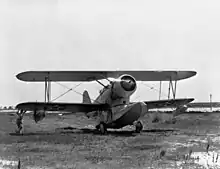Grumman JF Duck
The Grumman JF "Duck" was an American single-engine amphibious biplane built by Grumman for the United States Navy during the 1930s. The J2F Duck was an improved version of the JF, with its main difference being a longer float.[1]
| JF Duck | |
|---|---|
 | |
| Grumman JF-2 Duck in United States Coast Guard service | |
| Role | Utility amphibian |
| National origin | United States |
| Manufacturer | Grumman |
| First flight | 24 April 1933 |
| Introduction | 1935 |
| Primary users | United States Navy United States Marine Corps Argentine Navy United States Coast Guard |
| Number built | 48 |
| Variants | Grumman J2F Duck |
Design and development
The Grumman JF Duck was manufactured from 1934 until 1936, when production switched to the J2F Duck and later variants.[2] The more obvious external appearance clue to distinguish a JF from an early J2F is the deletion of the inter-aileron strut between the wings on the J2F; less noticeable perhaps is the J2F's slightly longer rear fuselage/float joining fillet beneath the tail.[2]
The Duck's main pontoon was part of the fuselage, almost making it a flying boat, although it appears more like a standard aircraft with an added float. The XJF-1 prototype first flew on 24 April 1933 piloted by Grumman test pilot Paul Hovgard.[3]
Operational history
The JF-1 that was first ordered had the same Pratt & Whitney R-1830-62 engine as the XJF-1 prototype. The US Navy ordered 27 JF-1s with the first Ducks delivered beginning in May 1934 to Norfolk NAS. These early production series had provisions for mounting a machine gun at the rear seat facing aft, as well as a single bomb rack mounted under each wing, capable of carrying a 100 lb (45.4 kg) bomb or depth charge on each. The main float was also a Grumman design (Grumman Model "A") and like the prototype, it included retractable main landing gear, making the Duck a true amphibian. Ducks served as general/utility amphibians for photographic, target-towing, scouting, and rescue work.
Variants
- XJF-1
- Prototype with 700 hp Pratt & Whitney R-1535-62 engine, one built (BuNo 9218).

- JF-1
- Production variant with 700 hp Pratt & Whitney R-1830-62 Twin Wasp engine, 27 built (BuNos 9434-9455, 9523-9527).
- JF-2
- Variant for the United States Coast Guard powered by a 750 hp Wright R-1820-102 Cyclone engine, 15 built (BuNo 0266, 00371-00372, 01647, USCG V141-V155).
- JF-3
- JF-2 for the U.S. Navy, five built (BuNos 9835-9839).
- Grumman G-20
- Armed version of the Grumman JF-2 for export to Argentina. Eight built.[4]
Operators
- Argentine Navy – Operated eight G-20s.[5]
- United States Navy
- United States Coast Guard
- United States Marine Corps – Operated one JF-2
Specifications (JF-2)
Data from [6]
General characteristics
- Crew: 2–4
- Length: 33 ft 0 in (10.06 m)
- Wingspan: 39 ft 0 in (11.89 m)
- Height: 12 ft 8 in (3.86 m)
- Wing area: 409.0 sq ft (38.00 m2)
- Empty weight: 4,100 lb (1,860 kg)
- Gross weight: 5,760 lb (2,613 kg)
- Fuel capacity: 150 US gal (120 imp gal; 570 L)
- Powerplant: 1 × Pratt & Whitney R-1830 Twin Wasp 14-cyl two row air-cooled radial piston engine, 775 hp (578 kW)
Performance
- Maximum speed: 185 mph (298 km/h, 161 kn) at 7,000 ft (2,100 m)
- Cruise speed: 155 mph (249 km/h, 135 kn)
- Stall speed: 63 mph (101 km/h, 55 kn)
- Range: 620 mi (1,000 km, 540 nmi)
- Service ceiling: 22,000 ft (6,700 m)
- Rate of climb: 1,600 ft/min (8.1 m/s)
See also
Related development
Aircraft of comparable role, configuration, and era
References
Notes
- Allen 1983, p. 49.
- Jordan, Corey C. "Grumman's Ascendency: Chapter Two." Archived 2012-03-25 at the Wayback Machine Planes and Pilots Of World War Two, 2000. Retrieved: 22 July 2011.
- Thruelson 'The Grumman Story' 1976, p. 77.
- Allen Air Enthusiast Twenty-three, p.78.
- Allen Air Enthusiast Twenty-three, pp. 47–48.
- Aviation April 1937, pp. 70–71
Bibliography
- Allen, Francis J. "A Duck Without Feathers". Air Enthusiast, Issue 23, December 1983 – March 1984, pp. 46–55, 77–78. Bromley, Kent UK: Pilot Press, 1983.
- "Specifications of American Airplanes". Aviation, Volume 36, No. 4, April 1937, pp. 66–71. (Registration required)
- Lezon, Ricardo Martin & Stitt, Robert M. (January–February 2004). "Eyes of the Fleet: Seaplanes in Argentine Navy Service, Part 2". Air Enthusiast (109): 46–59. ISSN 0143-5450.
- Thruelsen, Richard. The Grumman Story. New York: Praeger Publishers, Inc., 1976. ISBN 0-275-54260-2.
- Treadwell, Terry. Ironworks: Grumman's Fighting Aeroplanes. Shrewsbury, UK: Airlife Publishers, 1990. ISBN 1-85310-070-6.
Further reading
- Ginter, Steve (2009). Grumman JF/J2F Duck. Naval Fighters. Vol. Nº84 (First ed.). California, United States: Ginter Books. ISBN 978-0-942612-84-4. Retrieved 31 January 2015.
- Nuñez Padin, Jorge Félix (2002). Grumman G.15, G.20 & J2F Duck. Serie Aeronaval (in Spanish). Vol. Nº15. Buenos Aires, Argentina: Museo de la Aviación Naval, Instituto Naval.